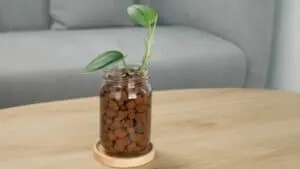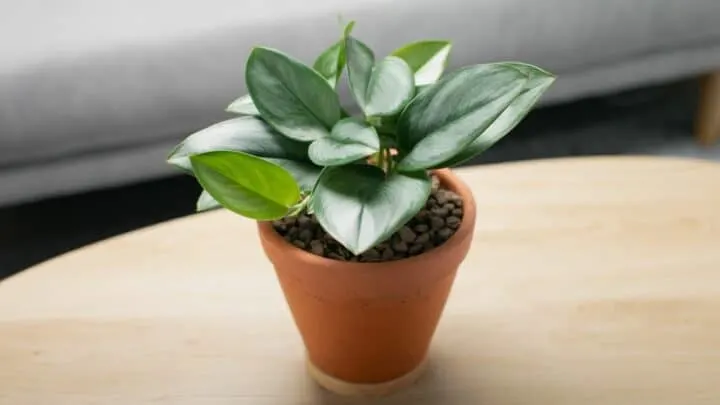The Scindapsus Treubii Moonlight plant, commonly known as Sterling Silver, is a sight to behold with its beautiful green leaves enhanced by a hint of silver.
It is a rare plant and so slightly hard to find; however, undoubtedly, it is well worth the effort.
The Scindapsus Treubii Moonlight hails from the Asian tropical rainforests.
It has 2 varieties: Scindapsus Dark form. Moonlight and Scindapsus Moonlight.
The former has milky-green leaves, while the latter showcases blackish leaves without any hints of silver.
Scindanapus Treubii Moonlight Care
Scindapsus Treubii Moonlight likes bright, dappled sunlight along with 60% humidity and temperatures between 65 to 75 degrees Fahrenheit (18.3 to 23.8 degrees Celsius). It is growing slowly and climbs walls and other ornaments. Put it in soil with a slightly acidic pH of around 6 containing a mix of peat moss and orchid bark. Feed it monthly for optimal growth and water about once a week.

Scindapsus Treubii Moonlight Care
Table of Contents
Scindanapus Treubii Moonlight Care Guide
Soil
If you want a healthy Scindapsus Treubii Moonlight plant, ensure that the soil is up to its liking. This plant likes organic, loose soils, preferably containing peat moss, sphagnum, orchid bark.
Keep the soil evenly moist for good hydration and ensure it is well aerated.
Furthermore, maintain a pH level lower than 6.0 for optimal growth.
Apart from helping the plant grow, the mild acidity aids in nutrient absorption and keeps bacterial and fungal infectious organisms at bay.
If buying commercially, I suggest getting soil especially manufactured for this rare species.
If not available at your local garden shop, make a soil mixture at home by mixing equal amounts of ground soil, peat moss, and perlite.
Water
When it comes to the Scindapsus Treubii Moonlight, avoiding overwatering is very important. Ensure that you do not let this humidity-sensitive plant sit in water for too long.
Water about once a week.

Watering Scindapsus Treubii Moonlight
Apart from upkeeping an ideal watering schedule, make sure that its planting pot has good drainage.
Mostly, pots with two to three drainage holes work well.
If you are unsure when to water the Scindapsus Treubii Moonlight plant, simply poke your finger into its soil. If the top two to three inches seem dry, add water.
On the other hand, if the soil feels moist, withhold the water till it dries out again.
Alternatively, you can wait for the Scindapsus Treubii Moonlight plant’s leaves’ sides to curl slightly.
This also indicates that the plant needs water.
I also recommend using room-temperature water with no chlorine. To achieve this, leave some water in a container overnight.
Use the chlorine-free water normally the next day.
Light
One of the prime growth determinants for any plant is sunlight. The same is the case with the Scindapsus Treubii Moonlight plant, which likes bright, dappled sunlight.
Indirect sunlight allows this tropical beauty to perform all its vital functions without burning the leaves.
Indoors, you can place the Scindapsus Treubii Moonlight plant in front of the west, east, or south-facing window.
Another option is to keep this plant next to a shaded balcony door.
The plant does fairly well under a large tree’s canopy or in partially covered patios and rooftops when growing outdoors.
The point here is to always keep the Scindapsus Treubii Moonlight plant under filtered sunlight because it is considerably light-sensitive and reacts to great light intensity by forming brown leafy tips.
Temperature
The Scindapsus Treubii Moonlight plant arises from the Asian tropical forests; therefore, it thrives in moderate to high temperatures.
The ideal range lies above 55 degrees Fahrenheit (12.7 degrees Celsius).
I keep my Scindapsus Treubii Moonlight plant at 65 to 75 degrees Fahrenheit (18.3 to 23.8 degrees Celsius) and, so far, I have had no problems with it.
Maintaining this range is pretty easy in temperate and tropical areas for most gardeners. However, in winters, you may have trouble upkeeping this range.
For the latter, I suggest either bringing the Scindapsus Treubii Moonlight plant indoors or placing it in the vicinity of a fireplace.
However, please be sure to avoid placing the Scindapsus Treubii Moonlight plant right next to a windy window or cooling and heating units; the direct drafts of wind may lead to shock.
Just ensure the plant has good aeration, and it will grow just fine.
Humidity

Using Hygrometer to Measure Humidity Levels
Another important factor when growing the Scindapsus Treubii Moonlight plant is humidity. It must be within the ideal range for the healthiest growth.
If the moisture is inadequate or excess, the plant shows various signs, including yellow leaves, dropping foliage, and wilting.
To prevent each of these problems, place the Scindapsus Treubii Moonlight plant in humidity levels higher than 60%, though it also does pretty well in levels as low as 40%.
You can increase the humidity levels either by misting the plant every other day or grouping it with your other houseplants.
Similarly, you can install a humidifier in the house and check the moisture levels with a hygrometer.
However, ensure that you do not mist the Scindapsus Treubii Moonlight plant’s leaves directly and wipe the excess off the leaves’ surface once you are done.
Fertilizer
The Scindapsus Treubii Moonlight is not a heavy feeder; it only requires a good-quality fertilizer once every month.
The feed should contain all macro and micronutrients, including Nitrogen, Phosphate, Potassium, Calcium, and manganese.
Each nutrient plays various yet equally vital roles in the plant’s life cycle.
I recommend fertilizing the plant with a liquid fertilizer once a month during the active seasons of summer and spring.
This feed type disintegrates quickly and keeps the plant well-fed for a month or slightly longer.
Another option is to use a slow-release fertilizer, which requires lesser feedings and breaks down pretty slowly.
However, since the Scindapsus Treubii Moonlight plant likes being fed every month, I suggest choosing the liquid one.
Avoid fertilizing Scindapsus Treubii Moonlight during the winter seasons as the plant has little to no activity during this time.
During these months, most plants go dormant and ready themselves for the up-and-coming growing seasons.
Repotting
The Scindapsus Treubii Moonlight has a manageable size, so it does not have to be repotted frequently.
When you see its roots circling the pot’s bottom or the vines outgrow their space, that is the best time to repot your plant.
Other indications of repotting include water-clogging, moderate to severe plant infection, and the topsoil requiring change.
Choose a pot at least 2 inches (5 centimeters) larger than a previous one. Replace the entire soil, adding the same ingredients, including sphagnum moss, orchid bark, and perlite.
Once you are done, ensure the roots are not crumpled and spread evenly inside the pot. Finish off by applying a fungicidal spray to the roots.
Pruning
If you think your Scindapsus Treubii Moonlight plant is growing out of shape or just needs a bit of tidying up, consider pruning it.
There is no set time for trimming off the branches, but most require it in about a year or so.
Start with cutting the vines that look most erratic or abnormal in any way (discolored, twisted). Ensure that each cut you make is sharp and does minimal damage to the surrounding buds.
Besides giving your Scindapsus Treubii Moonlight plant a fresh look, pruning also encourages new growth.
Please remember to disinfect each of your gardening and pruning tools before using them to minimize the risk of infection.
Propagation
Scindapsus Treubii Moonlight is a wonderful plant. But, propagating it can give you a bit of a challenge.
Gardeners often think their effort has gone to waste and the plant is not sprouting at all when actually, it is just a very slow grower.
The baby plant may take months to form one tiny leaf; thus, be patient with this one.
I usually propagate my Scindapsus Treubii Moonlight from stem cuttings. You can root them in water or sphagnum moss; the latter mostly works great.
Let’s start!
- Take a stem cutting off a healthy Scindapsus Treubii Moonlight. The cutting should have at least two to three leaves.
- Prepare a small pot containing a mixture of ground soil and sphagnum moss.
- You may dip the cutting’s end into some rooting powder to promote root formation.
- Now plant this cutting into your little pot and add some water to seal the plant in.
- Add some more sphagnum, so the moisture is ample.
- Cover the cutting with a plastic bag.
- Check on the cutting every day. If it seems dry, take off the bag and mist the stem. Put the bag on again.
- Repeat this until you see some new growth. It may be a leaf or a small node.
Blooms
The Scindapsus Treubii Moonlight plant does not grow flowers naturally except for little spadix that sprouts only during the growing seasons.
The plant is mostly famous for its stunning green and silver foliage.
Growth
The Scindapsus Treubii Moonlight, though it grows slowly, is well worth the wait. It gives rise to beautiful green and silver-striped leaves that have several impressed.
It grows actively throughout USDA hardiness zones 10B and above.
When growing in the wild or kept in conditions similar to its natural habitat, it reaches a height of about 96 inches (244 cm), and the leaves extend to approximately 4 to 20 inches (10 to 51 cm).
So, keep this beauty where there is plenty of space!
Common Problems for Scindapsus Treubii Moonlight
Yellow Leaves
One of the most common problems with the Scindapsus Treubii Moonlight plant is yellow leaves. They can form due to a wide variety of reasons; the most frequent one is inadequate sunlight.
The yellow leaves will not form at once. It starts off as small spots, which eventually coalesce to discolor the entire leaf.
To fix this problem, go over your plant’s entire care routine and make appropriate changes.
In the case of light settings, pick an east-facing window that allows in filtered sunlight. If the problem persists, review your watering schedule.
Curling Leaves
The next common issue with the Scindapsus Treubii Moonlight plant is curling leaves. This beautiful plant can manage quite well without water for a significant period.
However, if the environment is too dry or the plant is not watered for long, its leaves begin curling or twisting upon themselves.
The most frequent cause for this is underwatering. Please be sure to water your Scindapsus Treubii Moonlight plant every other day or whenever its soil’s top layer seems dry.
Moreover, mist the plant in a week once or twice.
Root Rot
Another major issue that arises when growing the Scindapsus Treubii Moonlight plant is root rot. It often occurs when the plant is watered excessively to the point its roots become soaked.
The soil also stays wet, attracting several pests, which includes aphids and spider mites.
To avoid this problem, allow the Scindapsus Treubii Moonlight plant’s soil to dry out between watering. If root rot has stricken the plant already, take out the plant, dry out the roots, and replant.
Tips for Growing Scindapsus Treubii Moonlight
- Choose a stem with either at least one node or three leaves when propagating.
- When pruning, remove the bottom leaves instead of the top ones.
- Propagate in sphagnum moss and perlite for the healthiest growth.
- Ensure that you put the cut nodes side-down a few inches deep in the pot.
- After transplanting, water the plant thoroughly.
Frequently Asked Questions about Scindapsus Treubii Moonlight Care
What is the best fertilizer for the Scindapsus Treubii Moonlight plant?
The best fertilizers for the Scindapsus Treubii Moonlight are nutritious, organic fertilizers with essential macro and micronutrients. However, commercial feeds made explicitly for Scindapsus Treubii Moonlight also work great.
How should I care for my Scindapsus Treubii Moonlight plant?
Place the Scindapsus Treubii Moonlight in bright, dappled sunlight in humidity levels greater than 60%. Moreover, maintain temperatures between 65 to 75 degrees Fahrenheit (18.3 to 23.8 degrees Celsius) and plant in well-draining pots.
Is the Scindapsus Treubii Moonlight plant toxic?
The Scindapsus Treubii Moonlight is toxic to kids, adults, and pets when ingested. It can cause swelling of the oral mucosa and other gastrointestinal tissues.
What is the best humidity for Scindapsus Treubii Moonlight plant?
Scindapsus Treubii Moonlight does best in humidity levels over 60%; however, it can also manage moisture levels as low as 40%.
Does the Scindapsus Treubii Moonlight grow fast?
The Scindapsus Treubii Moonlight plant is a slow-grower. It may take 3 or more months for this plant to sprout a considerable number of leaves.
Conclusion
Scindapsus Treubii Moonlight is a stunning plant with fairly manageable needs.
Keep it in bright, filtered sunlight, temperatures over 65 degrees Fahrenheit, moderate humidity, and feed it every month for the healthiest growth.
Please admire this beauty from afar as it is toxic if ingested.

Daniel has been a plant enthusiast for over 20 years. He owns hundreds of houseplants and prepares for the chili growing seasons yearly with great anticipation. His favorite plants are plant species in the Araceae family, such as Monstera, Philodendron, and Anthurium. He also loves gardening and is growing hot peppers, tomatoes, and many more vegetables.


